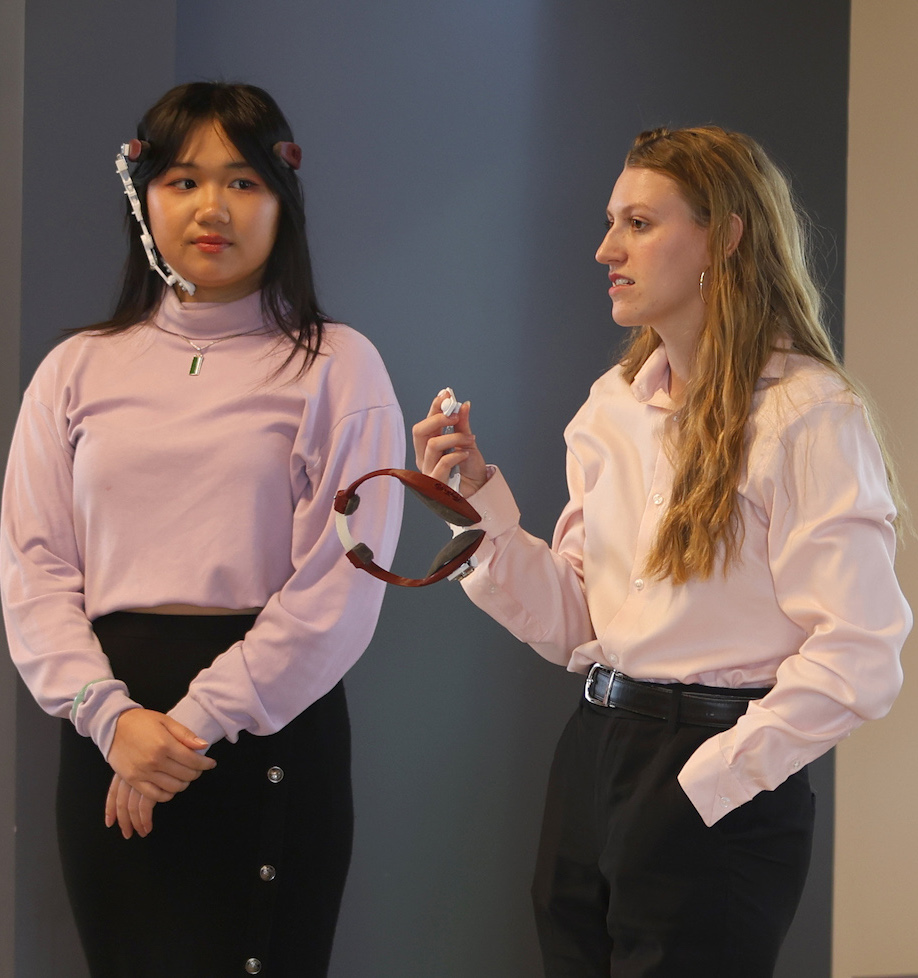Senior Engineers Drop Final Project

“Dropping in three, two, one.”
Then a drone, flying 150 feet high, released a plastic, hexagonal safety pod housing a blinking computer chip, amusing dozens of people gathered to watch one of two final presentations by the engineering design team on Lovik Field at Westmont.
The craft, trailed by a parachute, hit the grass, and a piece of the outer pod wall appeared to break off.
Westmont student Caleb Wilcox, a member of the engineering team sponsored by Northrop Grumman, retrieved the safety pod. “The Arduino computer chip attached to the spring panel still works perfectly well,” Elijah Cicileo announced to cheers. “The little LED is still blinking, so it was a perfect success.”
Wilcox explained that the team dropped a lighter version of their final project. “With only one pod inside, no top crumple zone and a reduced inner chamber, the revised weight met the drone’s lift capacity,” he said.
Daniel Jensen, director of engineering at Westmont, says companies favor installing instruments on weather balloon packages because they’re inexpensive and difficult to detect. “Sometimes when these instruments and the data they’ve recorded fall to the ground, the parachute isn’t working right – and the instruments and the data can be very important,” he says. “This design allows us to salvage the instruments and data even if the parachute doesn’t work. Additionally, they designed it to withstand extremely cold temperatures at 100,000 feet.”

Prior to the drop, fellow Edge of Space team members Chase Goddard, Ethan Ha, and Mark Szekrenyi explained their goal of directing the crash’s energy to the right places during the impact.
“Car manufacturers are great at making sure the energy goes around the passenger compartment during accidents,” Jensen said. “The students have done the same thing here, except the instruments are the passengers we’re protecting. It’s actually good to see pieces break from the craft because it means the energy is going into causing that damage while saving the instruments.”
Northrop Grumman sponsored the high altitude, thermally protected, compartmentalized, impact-resistant drop vessel, and they’ve committed to funding next year’s senior projects.
The Air Force Research Group sponsored the second senior project, “Nerve Stimulation Device for Enhanced Human Performance,” and will also support a project next year.
Team members Maria Judy, Tasha Loh, Jonah Swanson, Becca Hudson, and Jacob Bailey noted that emerging technology about peripheral nerve stimulation, proven to reduce fatigue and improve cognition, could help soldiers. The technology focuses on the cranial nerves that originate from the brain stem and extend down through the neck.
The second team set out to design a user-friendly interface for devices that could keep soldiers awake and alert without the downsides of caffeine or other addictive substances. They created three different prototypes – neckband, ear-wrap, and wristband – and laid out circuitry for each before choosing a head-wrap design with an attached stimulation arm.
“I love the process of taking a design and seeing how it’s weak and how we can improve it by going back and iterating on it, especially after getting feedback from stakeholders and users,” Swanson said.
“You guys did an incredible job talking to users and stakeholders to figure out what made sense and then building it,” said John McIntire, a research analyst based in the Air Force Research Laboratory’s Sensors Directorate, who mentored the team. “The amount of engineering you guys did in nine months was incredible.”
The team announced it would seek a patent for its new creation they named Stimulife.







You must be logged in to post a comment.